Practice Free AZ-140 Exam Online Questions
HOTSPOT
Which users can create Pool4, and which users can join session hosts to the domain? To answer, select the appropriate options in the answer area. NOTE: Each correct selection is worth one point.


You have an Azure Virtual Desktop deployment that contains a host pool. The host pool contains 10
session hosts. The session hosts are configured by using a custom image and ephemeral disks.
You need to deploy Microsoft OneDrive for Business.
Which two actions should you perform for each session host? Each correct answer presents part of the solution. NOTE: Each correct selection is worth one point.
- A . Install FSLogix.
- B . Install the OneDrive sync app by using the per-machine installation option.
- C . Implement Application Masking.
- D . Install the OneDrive sync app by using the per-user installation option.
- E . Deploy an MSIX app attach package.
AB
Explanation:
The two actions you should perform for each session host in order to deploy Microsoft OneDrive for Business are:
HOTSPOT
You have an on-premises network.
All users have computers that run Windows 10 Pro.
You plan to deploy Azure Virtual Desktop to meet the department requirements shown in the following table.

You need to recommend licenses for the departments. The solution must minimize costs.
Which license should you recommend for each department? To answer, select the appropriate options in the answer area. NOTE: Each correct selection is worth one point.
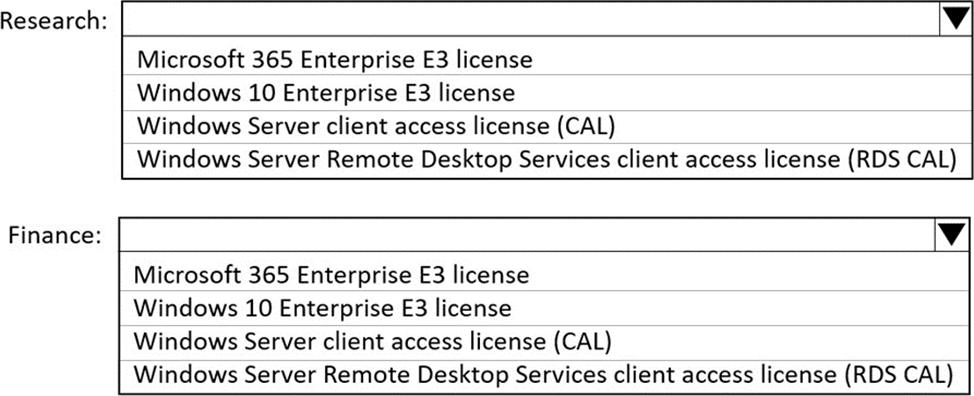
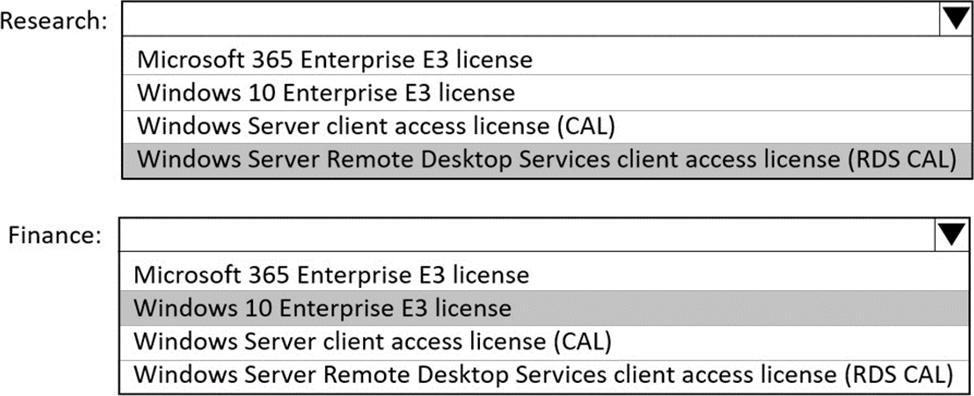
Explanation:
Reference:
https://docs.microsoft.com/en-us/azure/virtual-desktop/windows-10-multisession-faq
https://azure.microsoft.com/en-us/pricing/details/virtual-desktop/#pricing
HOTSPOT
You have an Azure Compute Gallery that contains the virtual machine image definitions shown in the following table.
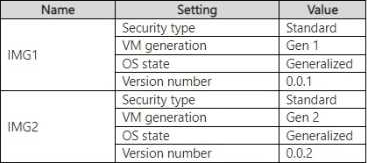
You create a new Azure virtual machine named VM1 as shown in the following table.

You need to prepare VM1, and then capture and share VM1 to the Azure Compute Gallery. The solution must minimize administrative effort.
What should you do? To answer, select the appropriate options in the answer area. NOTE: Each correct selection is worth one point.


You have an Azure Virtual Desktop host pool named Pool1 that contains three session hosts. The session hosts are configured to use FSLogix profiles.
On a management computer, you create an Application Masking rule and assignment files.
You need to apply Application Masking to the session hosts in Pool1.
What should you do?
- A . Generate a registration token.
- B . Install the FSLogix agent on the session hosts in Pool1.
- C . Compile the rule and assignment files.
- D . Copy the files to the session hosts in Pool1.
CD
Explanation:
FSLogix Application Masking is a feature that allows administrators to hide applications based on user assignments. To apply Application Masking to the session hosts in an Azure Virtual Desktop host pool, you first create the rule and assignment files on a management computer. After these files are created, you need to make them available to the session hosts.
Here’s what you should do with the rule and assignment files:
C. Compile the rule and assignment files: Before deploying FSLogix Application Masking rules, they need to be compiled into a format that the FSLogix agent can interpret. This is typically done using the FSLogix Rule Editor, which compiles the rules into an .fxr (rule file) and .fxa (assignment file) format.
D. Copy the files to the session hosts in Pool1: After the rule and assignment files are compiled, you need to place them in the correct location on each session host within the host pool where the FSLogix agent can apply them.
The other options are not directly related to the process of applying Application Masking rules:
You have an Azure subscription.
You need to deploy an Azure Virtual Desktop host pool that will contain 20 Windows 11 session hosts.
The solution must meet the following requirements:
• Each session host must have a Windows client license applied.
• Administrative effort must be minimized.
What should you use to deploy the session hosts?
- A . Microsoft Intune
- B . the Azure portal
- C . Windows Autopilot
- D . an Azure Automation runbook
HOTSPOT
You have an Azure Virtual Desktop deployment that contains a host pool named Pooll.
Pool1 contains five session hosts joined to an Active Directory Domain Services {AD DS) domain. You plan to use the Azure portal to add additional session hosts and specify a custom configuration.
Which type of custom configuration should you use. and where should you store the custom configuration? To answer, select the appropriate options in the answer area. NOTE: Each correct selection is worth one point.
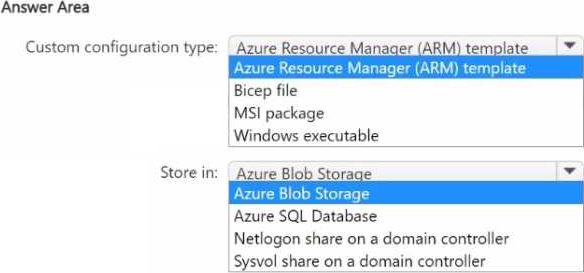
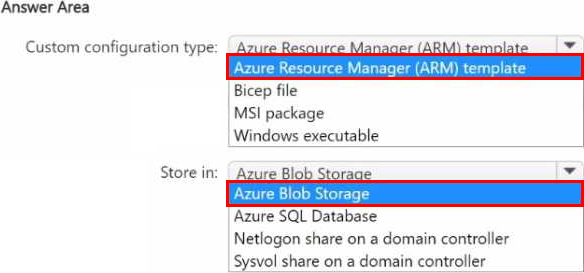
Note: This question is part of a series of questions that present the same scenario. Each question in the series contains a unique solution that might meet the stated goals. Some question sets might have more than one correct solution, while others might not have a correct solution.
After you answer a question in this section, you will NOT be able to return to it. As a result, these questions will not appear in the review screen.
You have a Windows Virtual Desktop host pool named Pool1 that is integrated with an Azure Active Directory Domain Services (Azure AD DS) managed domain.
You need to configure idle session timeout settings for users that connect to the session hosts in Pool1.
Solution: From an Azure AD DS-joined computer, you modify the AADDC Computers GPO settings.
Does that meet the goal?
- A . Yes
- B . No
HOTSPOT
You have an Azure subscription that contains an Azure Virtual Desktop deployment.
The subscription contains the virtual networks shown in the following table.

have virtual network peering configured as shown in the following table.

The deployment contains the session hosts shown in the following table.
Windows Defender Firewall is configured on each session host to allow all network traffic between the session hosts For each of the following statements, select Yes if the statement is true. Otherwise, select No. NOTE: Each correct selection is worth one point.
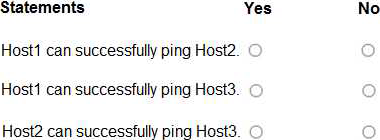
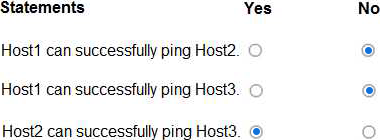
DRAG DROP
You need to ensure that you can implement user profile shares for the Boston office users. The solution must meet the user profile requirements.
Which four actions should you perform in sequence? To answer, move the appropriate actions from the list of actions to the answer area and arrange them in the correct order.


Explanation:
This sequence assumes that Admin1 has the necessary permissions to perform actions on the VM that will house the user profile shares, which would be the case if Admin1 is a domain admin or has equivalent permissions. The sequence of actions focuses on setting up the storage account, enabling Azure AD authentication, and then moving on to the VM to perform any final steps.
